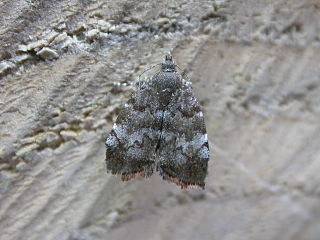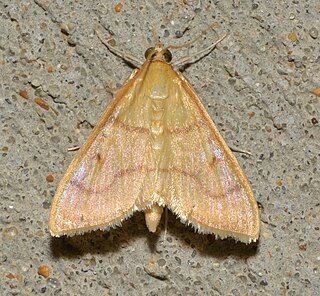
The Luna moth is a Nearctic moth in the family Saturniidae, subfamily Saturniinae, a group commonly known as giant silk moths. It has lime-green colored wings and a white body. The larvae (caterpillars) are also green. Typically, it has a wingspan of roughly 114 mm (4.5 in), but can exceed 178 mm (7.0 in), making it one of the larger moths in North America. Across Canada, it has one generation per year, with the winged adults appearing in late May or early June, whereas farther south it will have two or even three generations per year, the first appearance as early as March in southern parts of the United States.

The cinnabar moth is a brightly coloured arctiid moth found as a native species in Europe and western and central Asia then east across the Palearctic to Siberia to China. It has been introduced into New Zealand, Australia and North America to control ragwort, on which its larvae feed. The moth is named after the red mineral cinnabar because of the red patches on its predominantly black wings. The species was first described by Carl Linnaeus in his 1758 10th edition of Systema Naturae. Cinnabar moths are about 20 mm (0.79 in) long and have a wingspan of 32–42 mm (1.3–1.7 in).

Verbascum blattaria, or moth mullein, is a flowering biennial herb belonging to the Scrophulariaceae (figwort) family. A native to Eurasia and North Africa, it has naturalized in the United States and most of Canada since its introduction and has become an invasive species there. It has been declared a noxious weed by the state of Colorado.

Choreutis pariana, the apple-and-thorn skeletonizer or apple leaf skeletonizer, is a moth of the family Choreutidae. The moth was first described by the Swedish entomologist Carl Alexander Clerck in 1759. It is native to Eurasia and was introduced to New England, USA in 1917.
Phtheochroa modestana, the modest phtheochroa moth, is a species of moth of the family Tortricidae. It is found in North America, where it has been recorded from Alberta, eastward across southern Canada. In the United States, it is found from Maine to Illinois and South Carolina.
Archips fuscocupreanus, the exotic leafroller moth or apple tortrix, is a species of moth of the family Tortricidae. It is found in China, South Korea, Japan and Russia. It is an introduced species in the north-eastern United States, where it has been recorded from Connecticut, Massachusetts, New Jersey, New York and Rhode Island. It has also been recorded from Washington.
Neargyractis slossonalis, the dimorphic leafcutter moth, is a moth in the family Crambidae. It was described by Harrison Gray Dyar Jr. in 1906. It is found in Cuba and the south-eastern United States, where it has been recorded from Alabama, Florida, South Carolina, Georgia and Mississippi.
Petrophila schaefferalis is a moth in the family Crambidae. It was described by Harrison Gray Dyar Jr. in 1906. It is found in Mexico (Xalapa) and the southern United States, where it has been recorded from Arizona, California and Texas.
Trischistognatha pyrenealis is a moth in the family Crambidae. It was described by Francis Walker in 1859. It is found in Mexico, Central America, the West Indies and the southeastern United States, where it has been recorded from Georgia to Florida and from Alabama to Texas.
Hahncappsia alpinensis is a moth in the family Crambidae. It was described by Hahn William Capps in 1967. It is found in North America, where it has been recorded from Arizona, New Mexico and Texas.
Helvibotys helvialis is a moth in the family Crambidae. It was described by Francis Walker in 1859. It is found in North America, where it has been recorded from California to Florida, north in the east to Massachusetts, Quebec, Ontario, Michigan and Iowa.
Helvibotys pseudohelvialis is a moth in the family Crambidae described by Hahn William Capps in 1967. It is found in the United States, where it has been recorded from western Texas to Arizona and California and in Utah. It is also present in Sonora, Mexico.

Neohelvibotys neohelvialis is a moth in the family Crambidae. It was described by Hahn William Capps in 1967. It is found in the United States, where it has been recorded from Georgia and Florida to Arizona, as well as in the West Indies and from Mexico to Panama.

Pyrausta insignitalis, the dark-banded pyrausta moth, is a moth in the family Crambidae. It was described by Achille Guenée in 1854. It is found in the United States, where it has been recorded from Florida and South Carolina. It is also found on the West Indies, as well as in Central and South America.
Rhectocraspeda periusalis, the eggplant webworm moth, is a moth in the family Crambidae. It was described by Francis Walker in 1859. It is found in the West Indies and from the United States, where it has been recorded from Florida, North Carolina, Ohio, Oklahoma, South Carolina and Tennessee, south through Mexico and Central America to South America, including Ecuador, Brazil, Guyana, Trinidad and Tobago and Suriname.

Aroga trialbamaculella, the red-striped fireworm moth, is a moth of the family Gelechiidae. It is found in the United States, where it has been recorded from Maine to Florida and from Illinois to Texas.

Lacinipolia laudabilis, the laudable arches moth, is a moth of the family Noctuidae. It is found in the United States, where it has been recorded from Alabama, California, Florida, Georgia, Kentucky, Maryland, North Carolina, Oklahoma, Massachusetts, Pennsylvania, South Carolina, Tennessee, Texas and Virginia. It is also found in Mexico and Costa Rica. It has been recorded from Great Britain, where it was probably accidentally imported, but it might also be a rare immigrant.

Ponometia erastrioides, the small bird-dropping moth or small bird lime moth, is a moth of the family Noctuidae. It is found in North America, where it has been recorded from the eastern United States and south-central Canada. The habitat consists of fields, waste places and riparian areas.
Loxomorpha flavidissimalis is a moth in the family Crambidae. It was described by Augustus Radcliffe Grote in 1877. It is found in the United States, where it has been recorded from Texas, Florida, North Carolina and West Virginia. It is also found in Mexico and Puerto Rico. It has also been recorded from Australia.
Nites betulella, the black-dotted birch leaftier moth, is a moth in the family Depressariidae. It was described by August Busck in 1902. It is found in North America, where it has been recorded from Nova Scotia, southern Canada, the north-eastern United States, British Columbia and Wisconsin.









